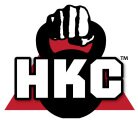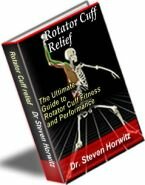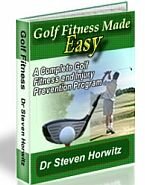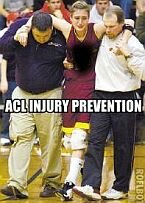Golfer's Back
 GOLF FITNESS MADE EASY A Complete Guide To Golf Fitness and Injury Prevention |
 ROTATOR CUFF RELIEF: The Ultimate Guide to Rotator Cuff Fitness and Injury Prevention |
As amateur golfer's, many of us have something in common with Jack Nicklaus and Lee Travino - a bad back. If you are among those who have already experienced a bout with this affliction, then you know how debilitating it can be. Low back pain accounts for almost 25% of all athletic injuries. In the western world, 80% of the population will experience disabling low back pain during their lives. Back pain is now second only to the common cold as a cause of employee absenteeism and, in 1992, cost the U.S. economy $60 billion. A 1989 workers' compensation study from Liberty Mutual revealed the average cost of a low back pain case was $8,321. Low back pain clearly represents the single greatest and most inefficient expenditure of health care resources in our society today.
Understanding the anatomy of the back will help you understand why and how back problems occur. The spine is composed of 24 bones called vertebrae. The lower back or lumbar spine has five vertebrae. In-between each pair of vertebrae are cushions called discs. The main responsibility of the disc is to absorb the compressive forces to which the spine is subjected.
There are three main muscle groups of the back. The muscles which parallel the spine are called the erector spinae. They, as the name suggests, keep the spine erect. They lift you up from a bent forward position. The quadratus lumborum is a deep muscle which runs from the lower ribs to the hip bone on each side. It helps you breath in air and side bends you. The hip flexors, or iliopsoas, run from the front of the lumbar spine to the thigh bone or femur. This muscle helps lift the knee up and is used when doing a full sit-up (more on this later).
Most back pain is preventable and often is caused by too little exercise, over exertion, overuse, poor form, lack of flexibility, and poor posture. Smoking and obesity are also implicated. These may result in arthritic or degenerative changes in the spine, disc herniations (commonly called slipped discs), muscle spasms, spinal joint irritation and dysfunction and nerve irritation. Non-musculoskeletal and potentially more serious problems like cancer, kidney disease, gallbladder disease, prostate disorders (all men over 40 should have a prostate examination yearly), ovarian and uterine disorders and aortic rupture may also cause back pain. A thorough examination to properly diagnose back pain is essential.
When golfer's think of the golf stance they don't realize how difficult it is to maintain the proper stance over 18 holes. A poor stance puts tremendous stress and strain on the lower back. Bending at the hips, not bending foward at the lower back is the key to preventing lower back pain. Strengthening the core muscles (abdominals, obliques, lower back, gluteal muscles and hamstrings) should be part of your golf fitness program. If you don't have a strong core you are in for big problems as well as poor performance. Flexing the knees requires strong quadriceps or front thigh muscles. If your quadriceps are weak you will fatigue more easily resulting in mishits and shorter distance. If your calves are too tight you will find it difficult to stay down at the ball.
The golf swing requires a repetitive, one-sided torquing of the spine. This eventually expresses itself as "Golf Body," or a change in one's posture due to muscular imbalances and lack of flexibility. This problem is actually worse in amateurs because of poor swing mechanics thus causing a greater load or stress on the lumbar spine. Remember, the average golfer will hit 50 full swing shots in a typical 18 hole match.
In his book, The Egosque Method of Healing In Motion, Peter Egoesque writes, "unless golf faces up to the indifference it has traditionally shown to the body and its proper functioning, the booming interest in golf won't last. The sport will be swamped in pain. Thirty and forty-year-olds who are now heading for the fairways in droves are the least functional generation who has ever teed up a golf ball. They bring dysfunction... by playing hour after hour, day after day, and this repetitive compensation motion injures them."
Over time these changes may cause spinal arthritis may develop. The discs narrow and wear out and the verebrae crumble often forming spurs which narrow and compress the area through which the spinal cord and nerves pass.
A disc herniation occurs when the outer wall of the disc weakens and the jelly like middle causes that outer wall to bulge out. The middle may even squirt out and form a separate fragment, like a piece of floating cartilage in the knee. This bulging may "pinch" the nerve exiting from the spinal cord or the spinal cord itself.
Most commonly, lower back pain is caused by a sprain and strain of the ligaments and muscles of the back causing spinal joint irritation and dysfunction and muscle spasm. Most of these injuries may be prevented by making some changes in your lifestyle and golfing habits.
If you are overweight, you must lose the spare tire. This additional weight puts tremendous pressure on the spine and discs. Recently, I had the opportunity to spend a day with Rocco Mediate at the TPC course at Sawgrass in Jacksonville, Florida. He had lumbar disc surgery one and a half years ago and underwent a rigorous rehabilitation program which included losing 50lbs.!
Smoking, believe it or not, may increase the risk of lower back problems because nicotine decreases the blood supply to the spine. Which is more important, your golf game or smoking? Maybe this can be your impetuous for quitting.
Many golfers are simply out of shape. Too many of us play a sport to get or stay in shape. It should be the reverse- you must get in shape to play a sport and this includes golf. This means a complete exercise program including aerobic exercise (20 minutes a day, three times a week), strength training (twice a week working on all the major muscle groups) and stretching.
A critical area for golfers is the midsection meaning the abdominals, the twisting muscles or obliques and the lower back muscles. Strengthen all of these, not only the abdominals, as a strong midsection will be able to handle all the torquing of the golf swing. See the exercises described at the end of the article.
Avoid the golf cart as the sitting position puts 40% more pressure on the discs than standing. It also causes you to cool down after each shot. Walk the course with a pull-cart as this will keep you warmed-up.
One thing which I find is almost never done by both professionals and amateurs is a proper warm-up or more appropriately put, proper prepartation. Don't confuse stretching and warm-up. They are BOTH part of preparation. Start by walking for at least five minutes. Then try some dynamic stretching of the calves, hamstrings, quadriceps, torso, shoulders, arms and neck. After this you may start swinging a club gently. Try gently swinging from the opposite side 10-20 times to balance the one-sidedness of your regular stroke. Proper preparation is crucial to injury prevention.
If you have back problems, you may want to try a long putter. The bent over and crouched position of putting puts much stress on the back.
Try cutting down on your swing in the more classic swing style. The "caddie swing" allows more control and puts less strain on the lower back.
Initial treatment for lower back problems is to stop your activity and ice the lower back for 20 minutes. Lie on your back with your knees bent directly on the ice pack. Gently try pulling one knee to your chest and hold that position for five seconds. Repeat this five times with each leg.
If the home care does not work, you may want to see a chiropractor. Chiropractic is a natural health care method that stresses the importance of keeping all the systems of the body functioning efficiently so the player enjoys peak performance, a minimum injury risk, and fast recuperative powers. The primary treatment of the Doctor of Chiropractic is an adjustment (manipulation) to those areas of the spine or surrounding joints which are slightly displaced and fail to function normally. Given by hand (the word chiropractic means "done by hand"), the adjustment will restore proper alignment and function to the spinal joints, thereby restoring the normal nerve transmission and healing potential to the vital structures of the body.
Just correcting the joint misalignments is not enough, however. You must see a chiropractor skilled in manual muscle therapies like Active Release Techniques® and Graston Technique. Any muscle tightness must be corrected by these techniques to allow the proper functioning of the joints AND for you to be able to get your body in the position your golf instructor wants you to be in. Finally, the chiropractor must have knowledge in golf specific rehabilitation techniques which are part of a complete treatment and performance program.
| The Ultimate Nutritional Lie Detector Test LEARN MORE  |
Kettlebell Rehab

Click Here
To See How Kettlebells will transform your body!
Vortex Rehab

Click Here
To See How This
Revolutionary Machine
Can Help You!
Partner / Support

Loans up to 3 months - fast cash advances for up to 90 days and up to $5,000!


















